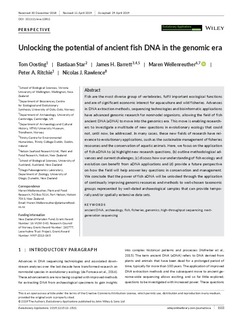| dc.contributor.author | Oosting, Tom | |
| dc.contributor.author | Star, Bastiaan | |
| dc.contributor.author | Barrett, James | |
| dc.contributor.author | Wellenreuther, Maren | |
| dc.contributor.author | Richie, Peter | |
| dc.contributor.author | Rawlence, Nicolas J. | |
| dc.date.accessioned | 2020-01-20T12:24:10Z | |
| dc.date.available | 2020-01-20T12:24:10Z | |
| dc.date.created | 2019-09-23T13:14:01Z | |
| dc.date.issued | 2019 | |
| dc.identifier.citation | Evolutionary Applications. 2019, 12 (8), 1513-1522. | nb_NO |
| dc.identifier.issn | 1752-4571 | |
| dc.identifier.uri | http://hdl.handle.net/11250/2637011 | |
| dc.description.abstract | Fish are the most diverse group of vertebrates, fulfil important ecological functions and are of significant economic interest for aquaculture and wild fisheries. Advances in DNA extraction methods, sequencing technologies and bioinformatic applications have advanced genomic research for nonmodel organisms, allowing the field of fish ancient DNA (aDNA) to move into the genomics era. This move is enabling researchers to investigate a multitude of new questions in evolutionary ecology that could not, until now, be addressed. In many cases, these new fields of research have relevance to evolutionary applications, such as the sustainable management of fisheries resources and the conservation of aquatic animals. Here, we focus on the application of fish aDNA to (a) highlight new research questions, (b) outline methodological advances and current challenges, (c) discuss how our understanding of fish ecology and evolution can benefit from aDNA applications and (d) provide a future perspective on how the field will help answer key questions in conservation and management. We conclude that the power of fish aDNA will be unlocked through the application of continually improving genomic resources and methods to well‐chosen taxonomic groups represented by well‐dated archaeological samples that can provide temporally and/or spatially extensive data sets. | nb_NO |
| dc.language.iso | eng | nb_NO |
| dc.publisher | Wiley Open Access | nb_NO |
| dc.rights | Navngivelse 4.0 Internasjonal | * |
| dc.rights.uri | http://creativecommons.org/licenses/by/4.0/deed.no | * |
| dc.title | Unlocking the potential of ancient fish DNA in the genomic era | nb_NO |
| dc.type | Journal article | nb_NO |
| dc.type | Peer reviewed | nb_NO |
| dc.description.version | publishedVersion | nb_NO |
| dc.source.pagenumber | 1513-1522 | nb_NO |
| dc.source.volume | 12 | nb_NO |
| dc.source.journal | Evolutionary Applications | nb_NO |
| dc.source.issue | 8 | nb_NO |
| dc.identifier.doi | 10.1111/eva.12811 | |
| dc.identifier.cristin | 1727825 | |
| dc.relation.project | Norges forskningsråd: 262777 | nb_NO |
| cristin.unitcode | 194,31,5,0 | |
| cristin.unitname | Institutt for arkeologi og kulturhistorie | |
| cristin.ispublished | true | |
| cristin.fulltext | original | |
| cristin.qualitycode | 1 | |

